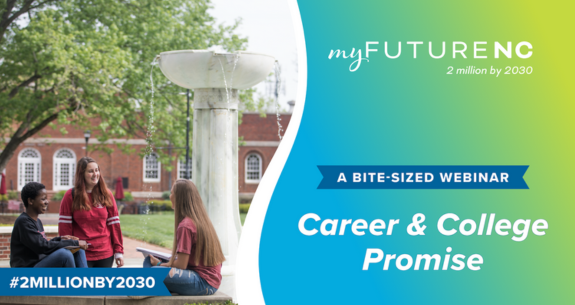This post is the seventh in our series about myFutureNC’s Bite-Sized Webinars. Previous posts covered Family-Sustaining Wages, Labor Market Alignment, FAFSA and Financial Aid, NC Pre-K, Opportunities for Growth, and Opportunity Youth.
NC Has One of the Nation's BEST Career and College Promise Programs
This seventh Bite-Sized Webinar from myFutureNC focused on the Career and College Promise (CCP) program for high school students. This webinar contained an overview of the CCP program and its benefits for students and also included examples of how one school district is encouraging student participation in CCP. In this post we will be summarizing the webinar and also exploring our region’s CCP data using the attainment profile for the Land of Sky region and for the four individual counties our region comprises: Buncombe, Henderson, Madison, and Transylvania.
Kim Case, myFutureNC’s Regional Impact Manager for the Northwest Region and Interim Regional Impact Manager for the West Region, facilitated this Bite-Sized Webinar on May 14, 2024. Ms. Case called out the CCP statistic at the bottom of the attainment profile: for the state of NC, 36,251 (36%) of high school students participated in CCP programs in 2023. That means that just over 1 out of 3 high school students across the state participated in the program.
According to the 2024 attainment profile for the Land of Sky region (relevant section shown below with the CCP participation rate outlined in red), 1,714 high school students (50%) participated in CCP, versus 36% in the state. Related data points (outlined in orange in the image below) pertain to the numbers of Career and Technical Education (CTE) credentials and concentrations earned by our students: 6,109 CTE credentials and 2,457 CTE concentrations.
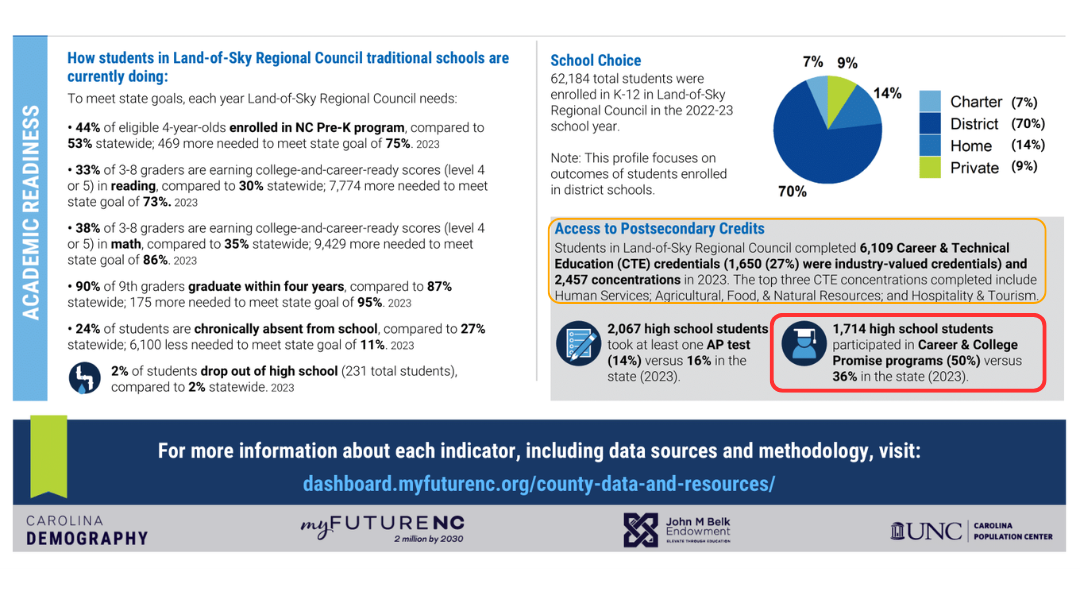
Overview of the Career and College Promise (CCP) Program in North Carolina
Sneha Shah-Coltrane, Director of the Office of Advanced Learning and Gifted Education at the NC Department of Public Instruction (NCDPI), gave an overview of the CCP program, which is also known as dual enrollment. (Students in the CCP program are considered simultaneously enrolled in, and often earning credits that count for, both high school and college.) She noted the 2011 law that provided structure to what had been a disorganized patchwork of options for high school students to access college credits. Previously, students had taken a college course here and there with no defined, overall goal or outcome. With the passage of the 2011 law, the CCP program became focused on getting students on specific pathways to earn credentials, diplomas, or degrees.
Ms. Shah-Coltrane then explained the three different pathways within the current CCP program (shown in the image below):
- College Transfer Pathway (CTP)
- Career and Technical Education Pathway (CTE)
- Cooperative Innovative High Schools (CIHS)
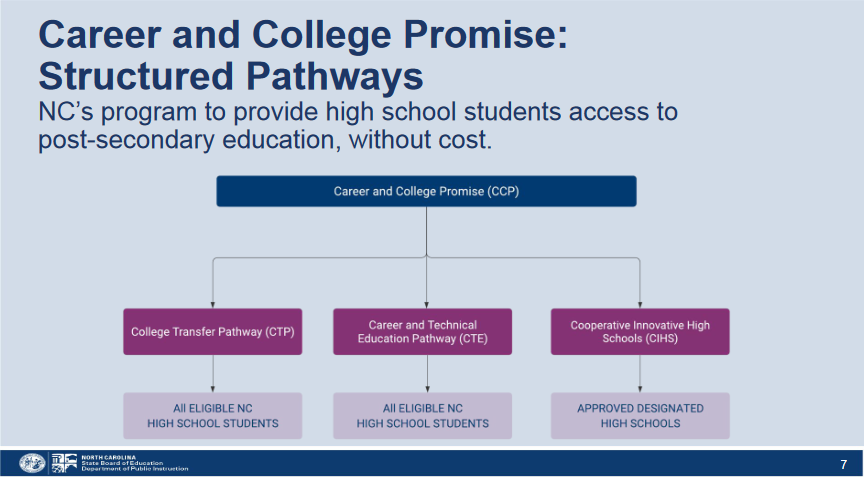
Next, she shared some statistics about the CCP program in NC. Finally, she discussed some of the benefits of the CCP program and some of the state and local infrastructure that supports the success of the program in NC. One notable benefit of the CCP program is that the courses are tuition-free for students, meaning students can earn college credit while they are still in high school and can save money on tuition costs while doing so.
Promising Practices for Increasing Participation in CCP
The promising practices section of this webinar featured Jamie Madren, who serves as the Center for Advanced Studies Coordinator/CCP at Brunswick County Schools and Brunswick Community College. Ms. Madren spoke about the importance of strong partnerships among staff and administration at the high school and between the high school and community college and of clear, effective communication and outreach with students and parents about the program. When speaking with parents, it’s important not to use acronyms (like CCP) but to instead use more familiar terms (such as dual enrollment). She gave several examples of how her district removes barriers to participation for students, including by providing transportation to the community college. She emphasized that the variety of pathways within the CCP program offer opportunities for every student.
When I talk with students, sometimes they think, “Oh, I can’t do a CCP class,” but really there is something for every senior out there. I really do believe that.
Connection to Our 2030 Goals for Educational & Workforce Attainment
The Career and College Promise (CCP) participation rate connects most closely to our strategic goal for the workforce:
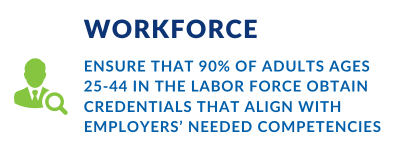
By providing opportunities for students to earn workforce credentials or college credits, tuition-free, while they are still in high school, North Carolina’s CCP program supports our efforts to ensure that 90% of adults in the labor force obtain credentials that are needed by our region’s employers. Students in the CTE pathway can complete their pathway while still in high school and can graduate ready to enter the workforce with a valued credential. The CTP pathway enables high school students to earn college credits that are guaranteed to transfer to any of the four-year universities in the UNC system, where they have a head start on finishing their credentials. The third pathway, CIHS, also provides opportunities for students to get ahead. At these specially designated high schools, which are also called early colleges, students are embedded in the community college campus beginning in 9th grade, and they have the opportunity to graduate with both a high school diploma and an associate’s degree. We have three CIHSs in the Land of Sky region: Buncombe County Early College, Henderson County Early College, and Madison Early College High School.
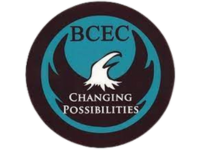
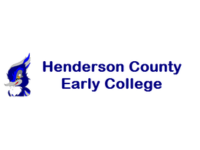
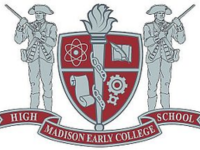
While we at the Land of Sky P20 Council do not have a specific strategic goal associated with CCP participation, we do have two key performance indicators (KPIs) that track this data because increasing CCP access and participation can increase credential attainment. We track the number of students who graduate with a credential (both CTE and CTP pathways) and also the percentage of students cross-enrolled during K-12. The chart for cross-enrollment shows data for our region’s two community colleges, each of which serves two of our counties. That chart provides both the overall numbers of CCP participation and also subdivides this data to show how many of those students were in each pathway: CTE, CTP, and CIHS.
CCP Participation Trends by County
The chart below shows trends in CCP participation for each of our four counties using data from the last three attainment profiles from myFutureNC (from 2020, 2022, and 2024). Buncombe County data includes both Asheville City Schools and Buncombe County Schools.
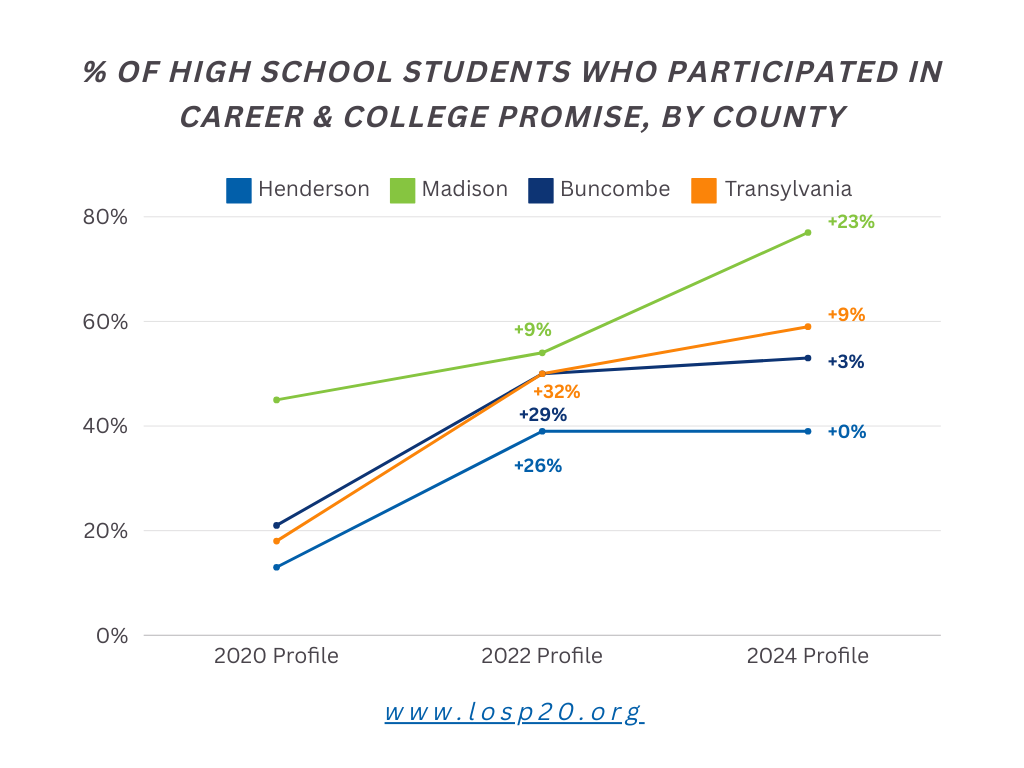
For all four of our counties, CCP participation increased significantly on the 2022 attainment profiles compared to 2020, with three of our counties experiencing double-digit percentage increases. Three of our counties (Buncombe, Madison, and Transylvania) also saw increases in their CCP participation rates on the 2024 attainment profiles compared to the 2022 profiles, with Madison having the biggest increase (23%), and Buncombe having the smallest increase (3%). Henderson County’s CCP participation rate remained flat on the 2024 attainment profile compared to the 2022 attainment profile. On all three attainment profiles, Madison County had the highest rate of CCP participation, and Henderson County had the lowest.
Check out our data dashboard for dozens more charts like the one above that track our progress toward our educational and workforce attainment goals.
CCP Participation by County and Comparisons to Peer Counties per the 2024 Attainment Profiles
On the attainment profiles for individual counties, myFutureNC compares their CCP participation rates to their peer counties. What are peer counties? Peer counties are all the other counties in the same urban/rural group as the subject county. All one-hundred counties in the state are classified using the rural/urban classification system of the NC Rural Center. According to this system, two of the counties in the Land of Sky region are suburban (Buncombe and Henderson), and two are rural (Madison is rural metro, and Transylvania is rural non-metro). Let’s look at each of our counties’ 2024 attainment profiles to see their CCP participation rates and how those compared to their peer counties.
Buncombe (suburban)
The 2024 attainment profile for Buncombe County, the most populous county in our region, indicates that 1,091 high school students (53%) participated in Career and College Promise, compared to 39% in peer counties, in 2023. This means that more than half (about 1 out of 2) students participated in the program, earning credits toward career and/or college credentials while still in high school. And, the county exceeded the average CCP participation rate of its peers by 14%.
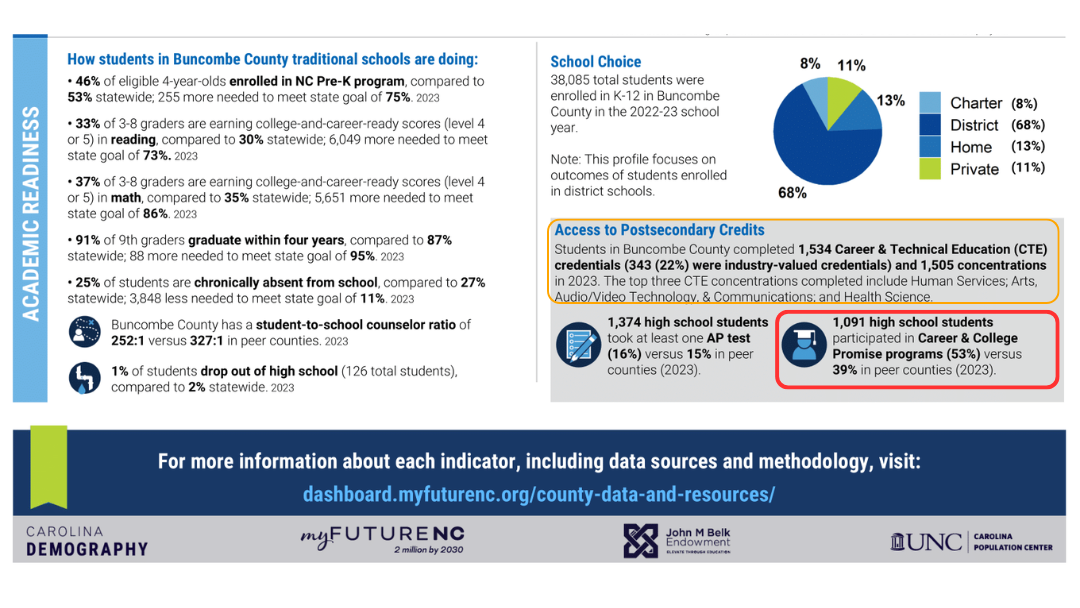
Henderson (suburban)
Henderson County’s 2024 attainment profile reports that 390 high school students (39%) participated in Career and College Promise, which matched the participation rate of its peer counties, in 2023. This translates to a little more than 1 out of every 3 students participating in the program.
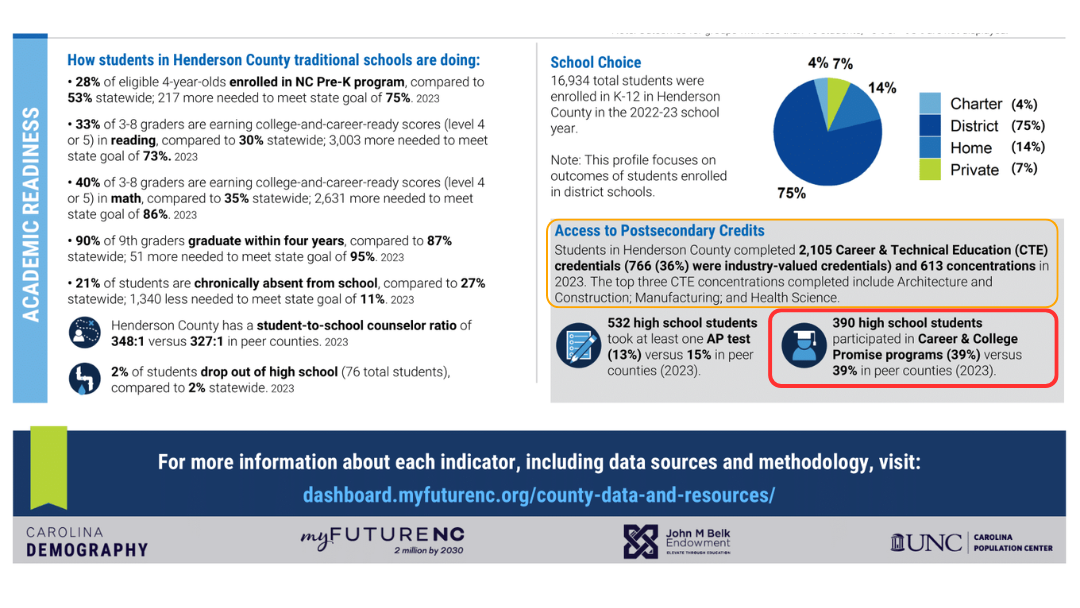
Madison (rural metro)
For Madison County, the 2024 attainment profile states that 106 high school students (77%) participated in Career and College Promise, compared to 43% in peer counties, in 2023. In other words, more than three-quarters of high school students in the school district (3 out of 4 students) participated in the program. This CCP participation rate is significantly higher–a difference of 34%–than the average for its peer counties.
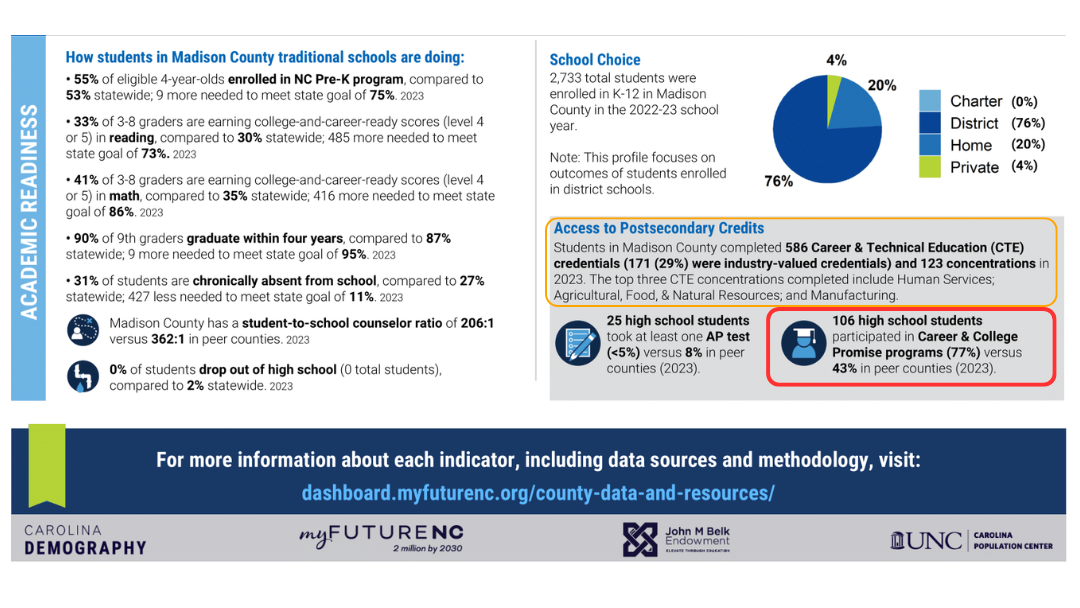
Transylvania (rural non-metro)
According to the 2024 attainment profile for Transylvania County, 127 high school students (59%) participated in Career and College Promise in 2023, versus 51% in peer counties. The county’s CCP participation rate of 59% means that more than half (1 out of every 2) of high school students in the district participated in the program.
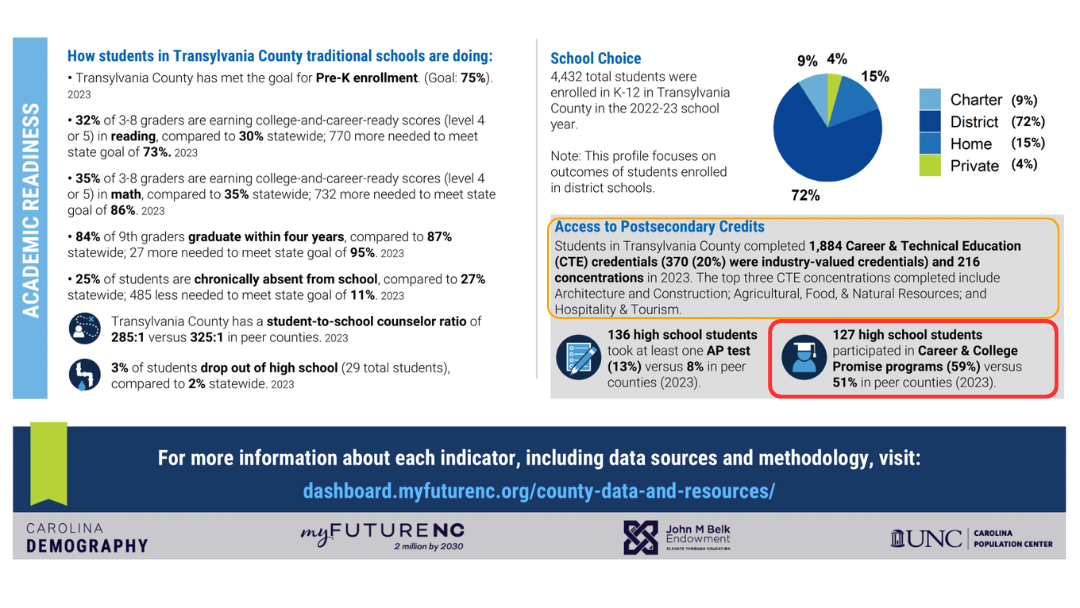
Land of Sky P20 Council's Efforts To Increase CCP Participation
Policy Advocacy
We have policies in both the K-12 Education and Credentials & Workforce sections of our legislative agenda that pertain generally to Career and College Promise (CCP), and we also advocate for several associated strategies that apply to CCP specifically.
K-12 Education policy recommendation: Provide school districts with greater policy and legal flexibility to facilitate greater alignment to local and regional needs.
Strategies specific to CCP:
- Revise legislation to allow schools to align their schedules with their local community college to enable students to participate fully in the Career and College Promise program and take tuition-free college courses while in high school.
Credentials & Workforce policy recommendation: Expand and strengthen coordination between K-12 and higher education to promote postsecondary pathways leading to recognized credentials leading to high-demand jobs with sustainable salaries and benefits.
Strategies specific to CCP:
- Review all CCP operating requirements to make access to the high-school-to-community-college pipeline more accessible to all students in grades 9-12.
- Develop a web page identifying available pathways across NC.
- Hire a marketing firm to develop and roll out a CCP marketing campaign.
- Create a statewide data system for comprehensive credential measurements to ensure data pertaining to certifications, diplomas, and degrees is current and accessible for measuring progress to enable proactive decision-making at the state and local levels.
Credentials & Workforce policy recommendation: Expand and strengthen coordination between higher education and industry/employers to promote short-term and non-degree workforce training and pathways that lead to credentials aligned with in-demand, living-wage jobs.
Strategies specific to CCP:
- Develop statewide advisory boards in each of the career fields for input to the State of NC and colleges regarding needed skills, certifications, licenses, and training/education required to build a strong NC workforce.
- Fund Curriculum Improvement Projects (CIPs) to use business /industry input to review and refine curricula at the NCCCS and UNC.
Resources
We worked with the two community colleges in our region, Asheville-Buncombe Technical Community College (A-B Tech) and Blue Ridge Community College, to produce a series of short videos to help inform students and parents/guardians about the CCP program. Video topics include What Is Career and College Promise (CCP)?, What Pathways Are Available in Career and College Promise (CCP)?, What Are Career and Technical Education (CTE) Pathways?, What Is a Cooperative Innovative High School (CIHS)?, and What Are Workforce Continuing Education (WCE) Pathways?
Stay tuned for more in this series. Next up: Career and Technical Education (CTE).
